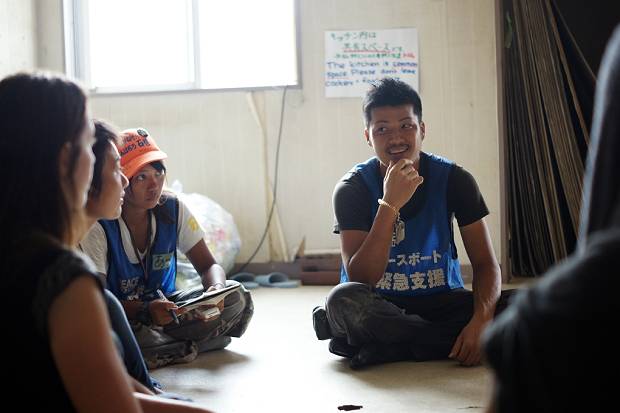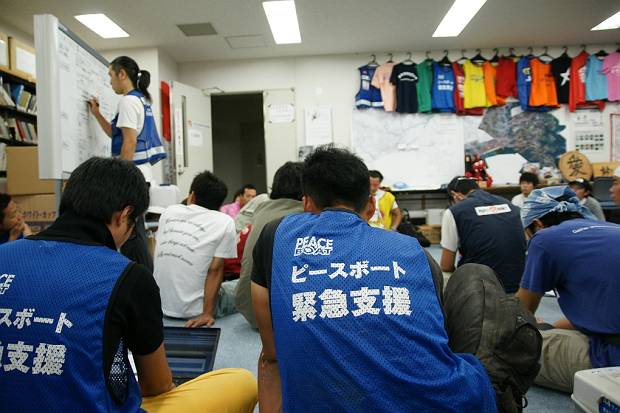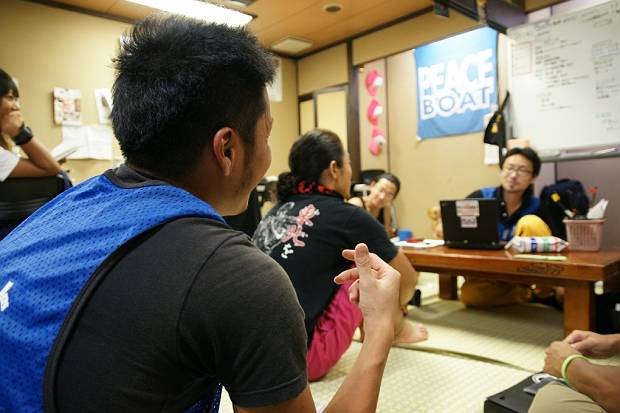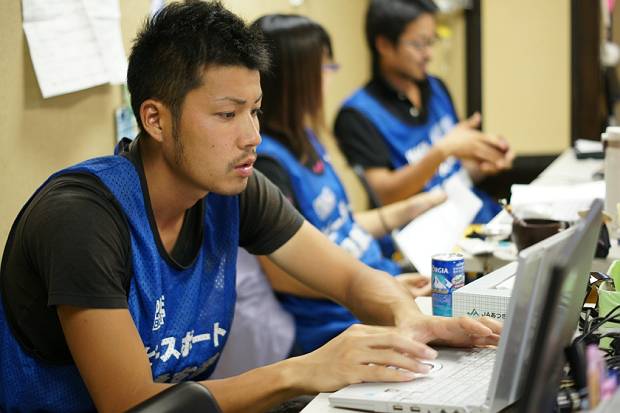
Activity Reports
Cleaning Assistant Director (AD) (Part 2)
October 8, 2011
(Continued from Part 1)
AD Ichijo, finishing work for the day. In the evening, the staff have a series of busy meetings going over the day’s work and making plans for the following day.

From 4:30pm, AD Ichijo meets with the team leaders at Kasuka Fashion, where the cleaning team are staying overnight. They discuss reports of the day’s activities, and improvements that can be made for the following day.

From 6:30 pm, he participates in the Ishinomaki Disaster Recovery Assistance Council meeting at the Ishinomaki Senshu University.

Then, from 8:15 pm at the Peace Boat Headquarters at Kouzan, a meeting is held to go over the day’s activities with the ADs of each division and the main directors.

Then from 9:30pm, further detailed meetings are held with the ADs and Leader leaders of the fishing industry support team and others working closely together, to go over fine details about the upcoming work and confirm procedures for the next day. Finally, this is the last meeting!
————————–
We found some time in between this busy day to interview Mr Ichijo.
Q: First, can you tell us a little about yourself – your age, where you are from, and your hobbies or favourite foods?
A: I am 25, and from Fukuoka. I enjoy making clothes (I used to study fashion design) and people watching. I really like looking at small details of people’s clothing and so on. As for sports, I played soccer in primary and hunior high school. I love crab cream croquettes – anything with creamy flavours. And also a spicy lotus root and burdock dish.
Q: How did you first learn about Peace Boat’s disaster relief volunteer activities?
A: Immediately after the disaster, I was searching for an organisation which I could volunteer in the affected areas with. As I had participated in Peace Boat’s 69th Global Voyage, I asked staff members that I know to contact me if Peace Boat would be sending volunteers. As soon as it was decided they contacted me, and so I participated right from the early days.
Q: What was your first impression upon arriving to Ishinomaki?
A: I arrived in Ishinomaki not so long after the disaster, on March 22. The situation went far beyond anything I had imagined from seeing photographs and video on the news, and I remember the moment I saw the debris there it suddenly changed to being my own personal issue. I went to the Minato Primary School, which was serving as an evacuation centre, and saw that the majority of people still did not have proper access to meals, and even before cleaning it was necessary to ensure that relief goods could be delivered.
In terms of human relations, it was really an extreme situation where people were moving not based on reason but on instinct. I’m not sure if it is to do with the culture in Tohoku, but there were many times when we delivered relief goods to individual homes but were turned away, told that “there must be other people in more need than we are,” but at times when materials were given out in bulk to larger groups of the community, the residents would then take many supplies. We see the same thing in the fishing industry support activities we are now carrying out – where fishermen at different ports and areas often say that “we hope that you won’t just help us, but will help people in the other ports just the same way,” always keeping in mind the balance in recovery of the fishing industry throughout the region.
Q: Could you tell us some of your motivation, things that have made you happy, or that have been difficult?
A: I’ve always liked to gather and coordinate people, or work behind the scenes to produce things. I would like to start my own business one day, and feel it is most important to not just be stuck behind a desk but to make sure you are out in the field using your body and experiencing different things. It is a position with a lot of responsibility and so of course I want to avoid making any fatal errors. However, I have learned that it is important to learn from small mistakes and reflect upon how things can continually be improved. In the early days, however, it was almost like a sense of mission, just feeling that we needed to do whatever needed to be done.
Moments when our efforts to create a good atmosphere or motivate volunteers are successful are always very fulfilling – which in my current position I am particularly considering all the time in the field. As for difficult moments… well, even if there were some I don’t really like saying that things are hard! If I had to say something, I suppose that I have often been in positions or jobs passed on from other people, and it can be challenging to go into something that is already up and running, as it takes a lot of physical energy.
Q: What are you hoping to do from now, and in what ways are you continuing to stay involved?
A: I plan to join the Disaster Volunteer Leader Training Programme (which will be announced at the October 13 event). Passing on our own experiences is something I would definitely like to put a lot of effort into from now.

As well as the six months experience in the field, AD Ichijo’s personal character and passion has certainly been a great support both to residents in Ishinomaki and the many volunteer members.
All photos by Nakamura Mitsutoshi
TAGS: cleanup • debris removal • delivery • Disaster Relief • Earthquake • evacuation centre • Ishinomaki • Japan • Kanto-Tohoku Earthquake and Tsunami • mud removal • Peace Boat • peaceboat • Relief • relief goods • Tokyo • Tsunami • Volunteer • volunteering • Volunteers


